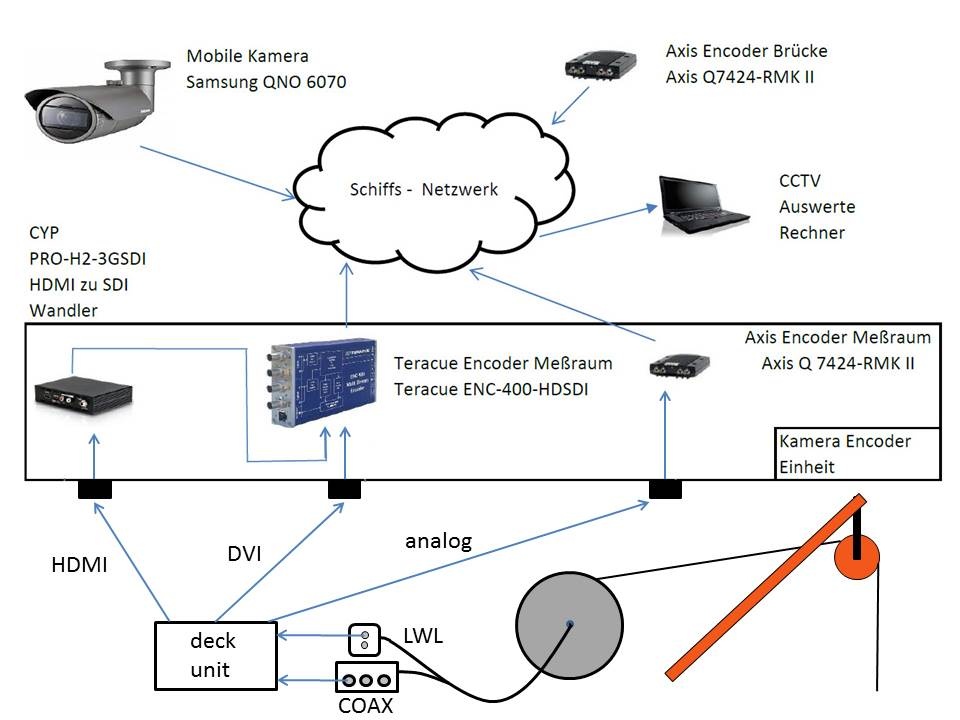An Bord Heincke besteht die Möglichkeit Video-Signale in das Bord-Netzwerk zu streamen:
1. Bord-Video
Zur Ansicht des achteren und seitlichen Arbeitsdecks, sowie der Spulschlitten der Vier-Trommelwinde sind Video-Kameras installiert. Die analogen Kamerabilder können auf Brücke, den Windenfahrständen und in den Laboren auf Fernsehbildschirmen angezeigt werden. Die Bilder können über einen Umschalter so arrangiert werden, dass auf einem Bildschirm das Bild einer einzelnen Kamera im Vollbild angezeigt wird, oder die Videos aller Kameras im Splitbild.
Auf Brücke ist ein Encoder installiert, der die Bilder des Bord-Videos in das Netzwerk streamt.
Eine mobile Kamera kann individuell installiert und die Signale unmittelbar in das IT-Netzwerk gestreamt werden.
2. Wissenschaftliches Video
Video-Signale von Kameras, die an wissenschaftlichen Geräten montiert über die Forschungsdrähte zu Wasser gelassen werden, können ebenfalls in das Bordnetz gestreamt werden. Auf der Vier-Trommel-Winde sind auf den Winden W1 und W4 COAX-Kabel und auf Winde W3 ein COAX/Lichtwellenleiter (LWL, Fiber Optic) aufgespult. Der Abgriff der COAX-Kabel und LWL-Adern erfolgt im Mess- und Registrierraum, wobei die COAX-Kabel an N-Type Buchsen und die zwei LWL-Adern an ST-Buchsen enden.
Werden über die Forschungsdrähte Video-Signale übertragen, können diese direkt oder indirekt in das Schiffsnetzwerk gestreamt werden. Die Einspeisung erfolgt über die Kamera-Encoder-Einheit, die direkt neben dem COAX-Patchfeld im Mess- und Registrierraum installiert ist. Es können wahlweise SDI, HDMI und analoge Signale eingespeist werden.
Für die Anzeige der Video-Streams kann z.B. der VLC-Player verwendet werden.
On board Heincke, it is possible to stream video signals to the on-board network:
1. on-board video
Video cameras are installed to view the aft and side working decks, as well as the winding slides of the four-drum winch. The analogue camera images can be displayed on TV screens on the bridge, the winch control stands and in the laboratories. The images can be arranged via a switch so that one screen displays the image of a single camera in full screen, or the videos of all cameras in split screen.
On bridge, an encoder is installed that streams the images of the on-board video to the network.
A mobile camera can be installed individually and the signals streamed directly into the IT network.
2. scientific video
Video signals from cameras mounted on scientific equipment launched over the research wires can also be streamed into the on-board network. COAX cables are spooled onto the four-drum winch on winches W1 and W4, and a COAX/fibre optic cable is spooled onto winch W3. The COAX cables and fibre optic wires are tapped in the measuring and recording room, with the COAX cables ending at N-type sockets and the two fibre optic wires ending at ST sockets.
If video signals are transmitted via the research wires, they can be streamed directly or indirectly into the ship's network. The feed is via the camera encoder unit, which is installed directly next to the COAX patch panel in the measuring and registration room. A choice of SDI, HDMI and analogue signals can be fed in.
The VLC player, for example, can be used to display the video streams.
Einspeisung von Video-Signalen in das Schiffsnetzwerk.
Feeding video signals into the ship's network.
